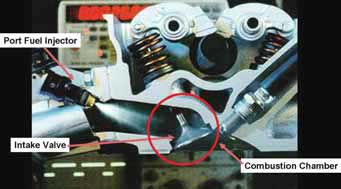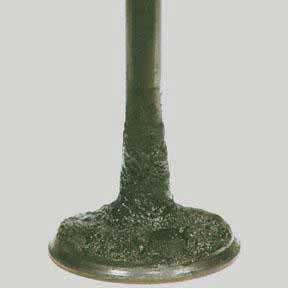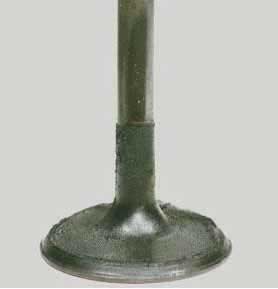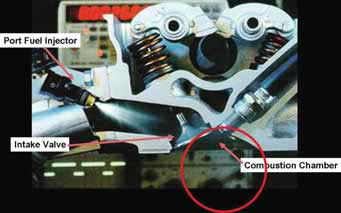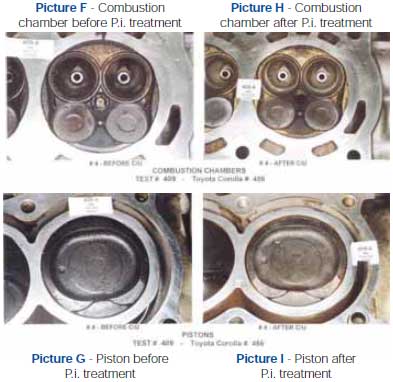
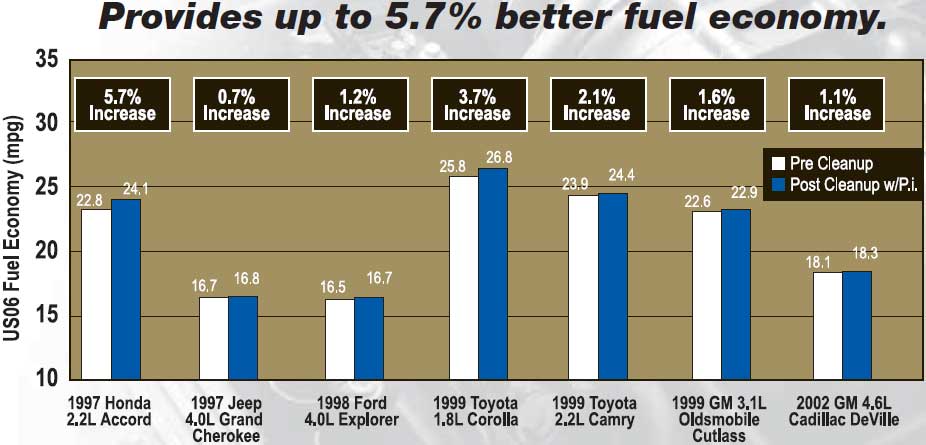
In response to Environmental Protection Agency (EPA) fuel economy and emissions regulations, fuel injection systems replaced carburetors in new vehicles in the 1980s. Fuel injectors provide drivers with more precise control of fuel, improving fuel efficiency and minimizing emissions. However, in order to work efficiently, they must be kept clean. Because performance suffers as fuel injectors become dirty, the U.S. government man- dated in the mid-1990s that all gasoline sold in the U.S. be formulated with a lowest additive concentration (LAC) level of detergent additives to help keep engines clean and emissions under control. However, it takes a very low level of additive to pass the tests, and most gasoline on the market contains as little as 123 parts per million (ppm) of additive.
The low levels of detergent additives in modern gasoline allow deposits to build up on critical fuel system components, and most motorists are unaware of how dirty the insides of their engines are. AMSOIL P.i. Performance Improver is an effective one-tank, total fuel system cleaner. More potent than other fuel additives on the market, P.i. effectively cleans everything the fuel touches, including fuel injectors, intake valves and combustion chambers, in only one single tank of gasoline, removing the deposits that have built up over thousands of miles. Removing engine deposits with P.i. effectively improves fuel economy, reduces emissions, restores power, performance and acceleration, reduces octane requirements, increases engine life and reduces maintenance costs.
Port Fuel Injectors
Port fuel injectors are standard equipment in modern vehicles, providing the exact amount of gasoline the engine needs. Their task is to transfer liquid gasoline from the tank and spray it in a fine mist into the intake air stream, increasing surface area and allowing the gasoline to evaporate into a gaseous state as it enters the engine. There are two types of port fuel injectors: pintle and director plate.
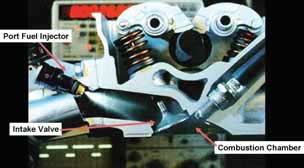
Pintle Style Injectors
Pintle style fuel injectors feature a pintle-shaped spray tip that produces a hollow cone of spray, at least when it is clean and working properly. Picture A shows a greatly magnified pintle tip with bits of built-up deposits. These deposits, although they don't look like much to the naked eye, can signifcantly alter the spray pattern of gasoline. Picture A, as well as Pictures B and C show the spray patterns of a dirty injector and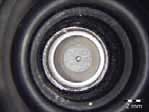 the same injector cleaned with P.i. Picture C shows an ideal spray pattern, a good mist with plenty of surface area for evaporation to take place. When deposits start to build up on an injector's pintle, the spray pattern looks more like Picture B, a steady stream of liquid gasoline. In order to burn properly, gasoline must evaporate to a gaseous form, and liquid gasoline has more diffculty evaporating. In addition, not as much fuel is delivered through a deposit-covered injector as a clean injector, leading to lean misfres in the cylinder.
the same injector cleaned with P.i. Picture C shows an ideal spray pattern, a good mist with plenty of surface area for evaporation to take place. When deposits start to build up on an injector's pintle, the spray pattern looks more like Picture B, a steady stream of liquid gasoline. In order to burn properly, gasoline must evaporate to a gaseous form, and liquid gasoline has more diffculty evaporating. In addition, not as much fuel is delivered through a deposit-covered injector as a clean injector, leading to lean misfres in the cylinder.
Director Plate Injectors
While pintle style fuel injectors were common in the 1980s, modern vehicles feature director plate injectors that control fuel fow through a simple wafer. Featuring a pre-determined number of holes, pressure drop across the wafer forms the spray of fuel through the holes. The more holes that are in the wafer, the better the fuel atomization. However, as more holes are added to a director plate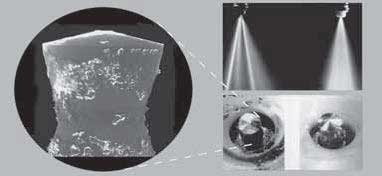 design, they must be made increasingly smaller in order to maintain the pressure drop. Twelve-hole wafers are common on modern vehicles, providing optimum atomization, fuel economy and emission levels. Of course, they must be clean and functioning properly to realize these benefits. Smaller holes are more sensitive to deposit formation and, like pintle style injectors, dirty director plate injectors lead to reduced fuel spray and heavy streams of liquid gasoline that do not allow adequate evaporation, leading to reduced fuel economy, increased emissions and Picture A drivability issues. Because the holes in a 12-hole injector are about the size of a human hair, they are very sensitive and it only takes a small amount of deposits to impede the flow of fuel.
design, they must be made increasingly smaller in order to maintain the pressure drop. Twelve-hole wafers are common on modern vehicles, providing optimum atomization, fuel economy and emission levels. Of course, they must be clean and functioning properly to realize these benefits. Smaller holes are more sensitive to deposit formation and, like pintle style injectors, dirty director plate injectors lead to reduced fuel spray and heavy streams of liquid gasoline that do not allow adequate evaporation, leading to reduced fuel economy, increased emissions and Picture A drivability issues. Because the holes in a 12-hole injector are about the size of a human hair, they are very sensitive and it only takes a small amount of deposits to impede the flow of fuel.
Picture A

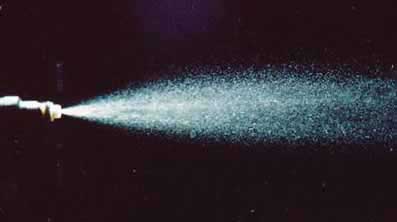
Picture B - Injector spray pattern before P.i. treatment
Picture C - Injector spray pattern after P.i. treatment
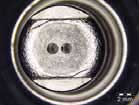
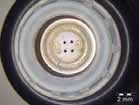
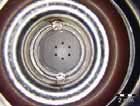
By measuring oxygen, the oxygen sensor in the exhaust stream is able to calculate how much gasoline the injectors are spraying, as well as the air/fuel ratio. Although vehicles are usually equipped with many fuel injectors (one per cylinder), only one oxygen sensor monitors them all. Through the oxygen sensor, the computer is able to determine if the engine is receiving the right amount of fuel. Deposit build-up on the injectors reduces the fuel flow. When the computer determines that the engine is not receiving enough fuel, it increases fuel flow from all the injectors in the fuel system. Although this solution would work well if all the injectors lost fuel flow at the same rate, injectors almost always plug at different rates based upon their operating temperatures (inboard cylinders typically run hotter) and individual manufacturing tolerances.
Port fuel injector deposits have a significant impact on fuel economy and emissions because they plug injectors at uneven rates, and the engine cannot compensate for individual cylinders. For example, a four- cylinder engine could have two plugged injectors, while the other two may only be mildly plugged or not plugged at all. The oxygen sensor indicates to the computer that the engine is not receiving enough fuel, so it increases the fuel supply to all four cylinders. Now the two injectors that were plugged are providing more fuel, but it still may not be enough, while the two injectors that weren’t plugged are providing more fuel than necessary. As a result, it creates a situation where two cylinders are running rich and the other two are running lean. Removing port fuel injector deposits allows the engine to operate as it was designed, improving fuel economy, lowering emissions and contributing to improved drivability (reduced stumbling, stalling, hesitation and rough idle) and increased power.
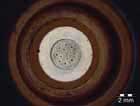
As more holes are added to director plate designs, they must be made increasingly smaller in order to maintain the pressure drop.
Injector Deposit Clean-Up Test
The ASTM 05598 Injector Clean-Up PFI Test was performed to test the fuel injector cleaning power of AMSOIL P.i. Performance Improver. Starting with a new, clean four-cylinder 2.2L Chrysler engine with new fuel injectors (an engine particularly sensitive to injector deposits), the car was driven and allowed to build up deposits for 2,728 miles on normal gasoline. Afterwards, deposit levels and injector flow rates were measured. The injectors did not develop deposits at the same rate, as two of the injectors were fouled >15%, one was fouled >10% and one was almost perfectly clean. After the measurements were recorded, the injectors were placed back in the car and the car was filled with a tank of gas treated with P.i. As seen in Graph A, all injectors returned to >95% flow after one tank of operation on P.i.
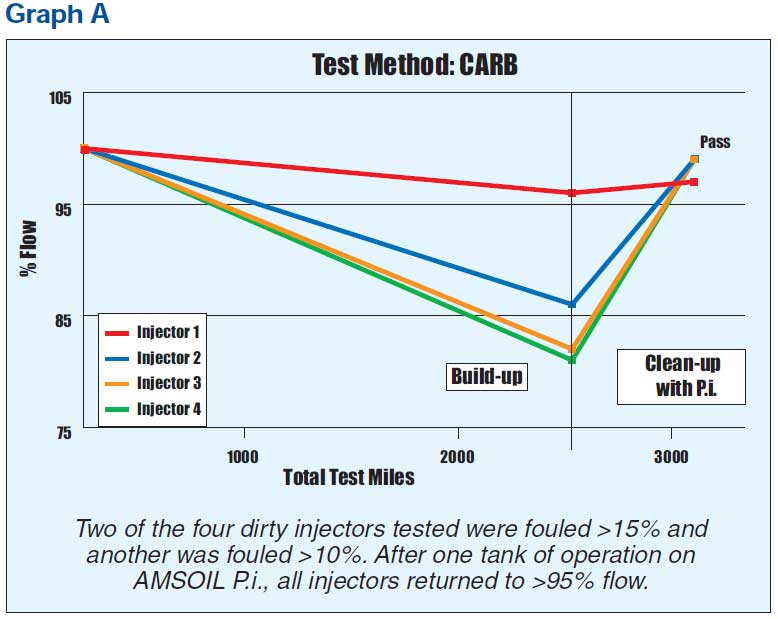
BMW Valve Deposit
Study BMW developed a specific interest in valve deposits in the late 1980s due to drivability problems with its vehicles, including stumbling, stalling, rough idle and hesitation. A study on valve deposits showed dirty valves were the source of the problems (Graph B indicates that as valve deposits increased, drivability problems increased), and the company invested a great deal of time and effort searching for solutions, trying everything from polishing the valve surfaces to using ceramic-coated valves. The solution that worked was adding a cleaning additive to the gasoline.
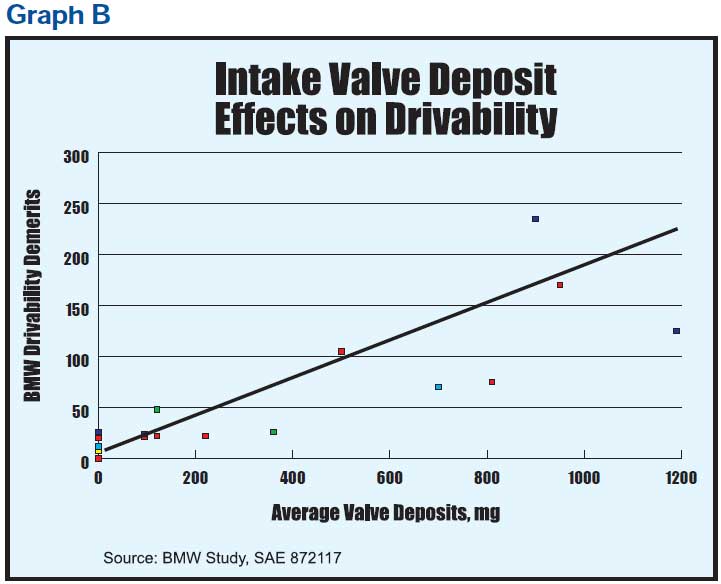
Intake Valve Deposit Clean-Up Test
A small fleet test performed on P.i. effectively demonstrates its superior deposit-cleaning abilities. The test focused on randomly selected model year 1997 to 2002 used vehicles with between 44,000 and 94,000 miles on the odometers, and all vehicles had been operated under normal service conditions using regular gasoline available on the market.
Before P.i. treatment, each vehicle was disassembled, and intake valve deposit levels were measured in a laboratory setting. Upon, completion, the vehicles were put back together and filled with one tank of P.i. treated gasoline. After running through that tank of fuel, the vehicles were brought back into the laboratory, where all measurements were taken again.
The red bars on Graph C represent the pre-treatment intake valve deposit levels of the vehicles, ranging from 49 mg to 414 mg. The blue bars represent the deposit levels after P.i. treatment, showing an average of 72 percent clean-up after only one tank of gasoline. Even the vehicles with minimal pre-treatment deposit levels cleaned up very well, showing an average 89 percent clean-up, with the Toyota Corolla showing 98 percent deposit clean-up.
| Vehicle Model | Mileage | Vehicle Model | Mileage |
|---|---|---|---|
| 1997 Honda 2.2L Accord | 85,000 | 1999 Toyota 2.2L Camry | 53,000 |
| 1997 Jeep 4.0L Grand Cherokee | 94,000 | 1999 GM 3.1L Oldsmobile Cutlass | 52,000 |
| 1998 Ford 4.0L Explorer | 57,000 | 2002 GM 4.6L Cadillac Deville | 55,000 |
| 1999 Toyota 1.8L | 44,000 |
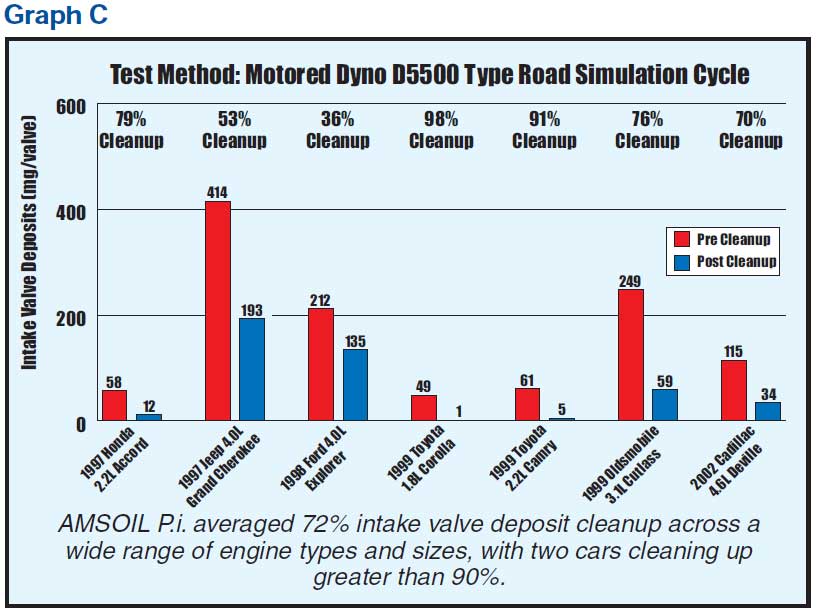
Combustion Chamber Deposit Clean-Up Test
The dark blue and red bars in Graph D indicate the piston top and cylinder deposit levels of each test vehicle prior to P.i. treatment, while the light blue and red bars indicate the deposit levels after one tank of operation on P.i.-treated gasoline. Every vehicle showed significant deposit clean-up, more than enough to remedy the octane number requirement increase, combustion chamber deposit interference and combustion chamber deposit faking problems associated with combustion chamber deposits.
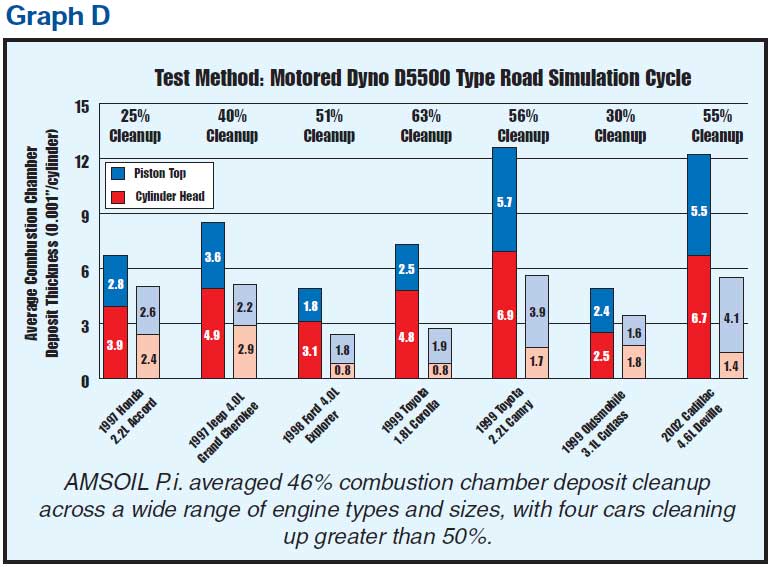
Fuel Economy Test
A primary concern for many motorists is fuel economy, and the clean-up of fuel injector, intake valve combustion chamber deposits effectively improves a vehicle’s fuel economy.
The fleet of test vehicles was put on a rolling chassis dynamometer before and after P.i. treatment, measuring each vehicle’s fuel economy numbers according to the same method mandated by the federal government and used by auto manufacturers to determine vehicle fuel economy ratings. The blue bars on Graph E indicate pre-treatment fuel economy numbers. The red bars indicate fuel economy following one tank of operation on P.i., showing an average fuel economy improvement of more than 2 percent. Although the Honda and two Toyota vehicles had the lowest levels of deposits prior to P.i. treatment, they experienced the largest fuel economy increases after treatment, indicating that even minimal levels of deposits can have significant effects on fuel economy. In fact, many smaller engines designed for maximum fuel efficiency are among the most sensitive to deposits.
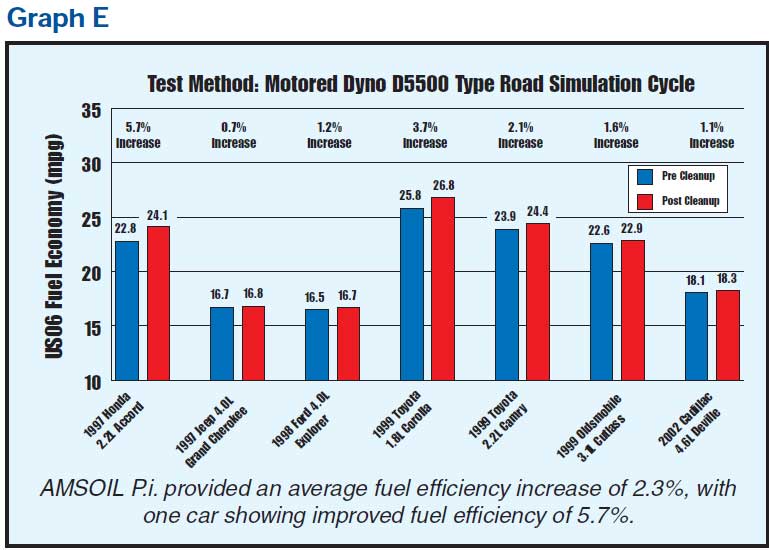
Carbureted Engines
Although modern vehicle models are equipped with fuel injection systems, there are still a number of older and classic carburetter cars on the roads. P.i. works just as effectively in carburetors as it does in fuel injectors, intake valves and combustion chambers, effectively cleaning the back sides of carburetor plates, the idle air passages and all of the fuel portals just as well as it cleans the components of a fuel injection system.
Picture J shows dirty, deposit-covered carburetor plates, while Picture K shows the same carburetor plates cleaned with P.i.


Benefits of P.i. Treatment
• Increases fuel economy Testing yielded improvement of up to 5.7 percent
• Restores power, acceleration and drivability to "like new" condition
• Reduces emissions and helps vehicles pass emission tests
Up to 15 percent reduction in hydrocarbon (HC) emissions (unburned fuel)
Up to 26 percent reduction in carbon monoxide (CO) emissions (partially burned fuel)
Up to 17 percent reduction in nitrous oxide (NOx) emissions
• Avoids necessity of expensive injector cleaning services
• Reduces engine octane requirement, saving money at the pump
Recommendations
Treat one full tank of gas up to 20 gallons with one bottle or up to 40 gallons with two bottles. Using more than two bottles per treatment is not recommended. Large gas tanks should only be partially filled to 40 gallons to maintain the proper concentration ratio of one bottle per every 20 gallons for best results. Treat every 4,000 miles (or 100 hours for marine, stationary and off-road gasoline-powered engines). P.i. helps pass emission tests (treat one full tank of gas, run that tank and fill up again prior to test). Safe for use with catalytic converters, oxygen sensors, oxygenated gas and 10% ethanol blended gas. Not recommended for two-cycle engines.



